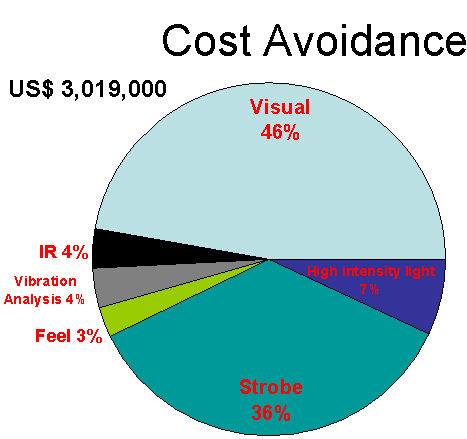We often get the following two questions:
1. With what condition monitoring technique are failures usually found?
2. What is the cost saving associated with finding failures?
The answer depends on the current equipment condition, the amount of equipment, the type of equipment, and what the consequences of failures are for a plant.
There isn’t a good answer until some data is taken for a particular plant. But to give you an example, we would like to present the data from a recent project (Case study).
Condition Monitoring Technique Used:
We collected data for question 1 above by assigning an inspection technique to each work request that turned into a work order. The study was done for 7 months. If a work order for a coupling was turned in, the condition monitoring technique used was assigned to that work order, for example: Found by stroboscope. By collecting data for seven months in a plant, we found the following:
How failures were found in this particular plant:
Visual inspection 46%
Stroboscope 36%
High intensity flash light 7%
Vibration analysis 4%
Infrared Thermography 4%
Feel 3%
Cost Savings from Condition Monitoring
To find the cost saving without using too much effort, the plant did a quick cost savings estimate for each inspection that saved downtime. For example, a coupling found in bad condition is estimated to have caused about 2 hours of downtime, and an unplanned job for maintenance.
The calculation would look like this:
A: Cost If coupling broke without warning: Downtime * Cost of Downtime/hr + Direct maintenance cost (unplanned & Unscheduled) + Potential damages
B: Actual cost of repair: Downtime (if any – should be fixed in scheduled shutdown) * Cost of Downtime/hr + direct maintenance cost (planned & scheduled) + Damages(= 0)
A- B = Cost avoidance
The cost avoidance calculation was done by operations and maintenance in the daily planning and scheduling meeting.
The result was a cost avoidance of $3,100,000 in 7 months.






